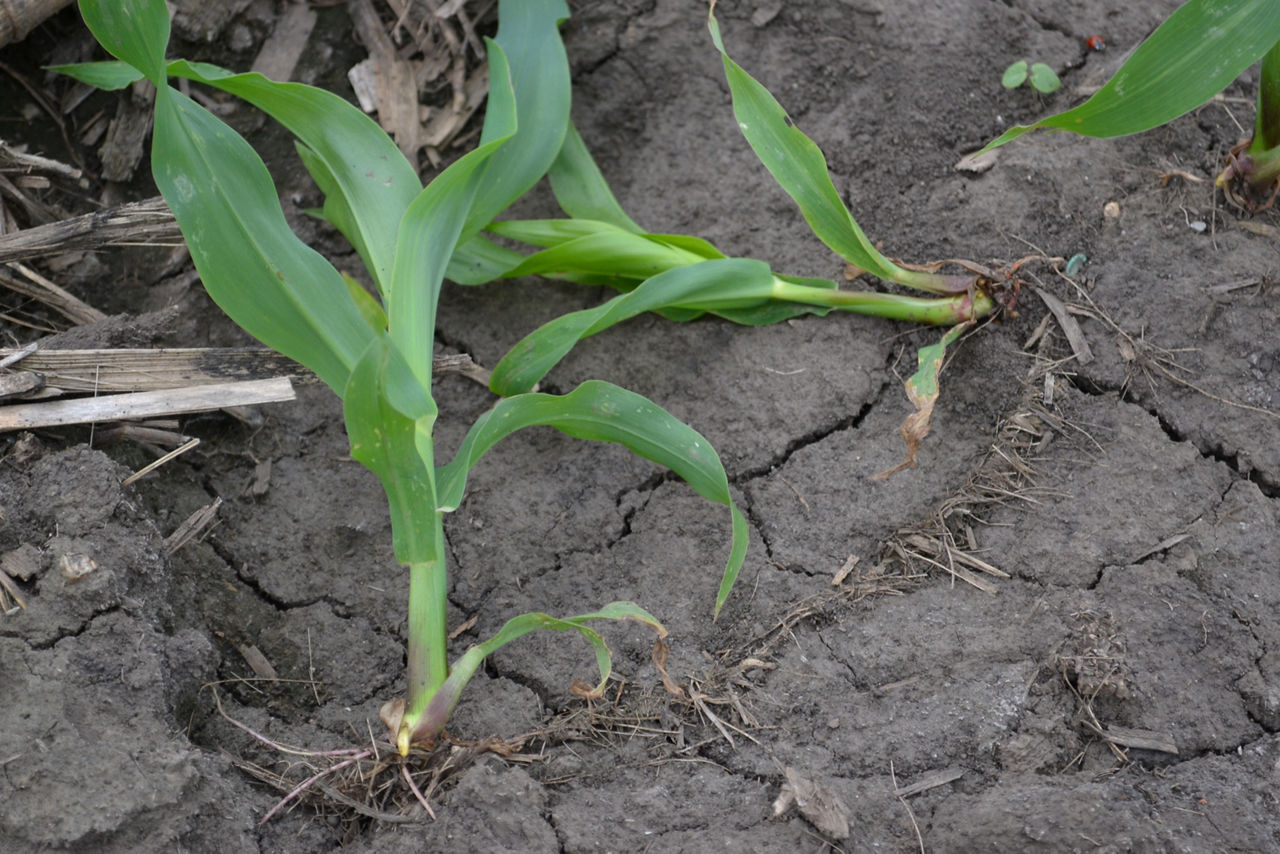3 MIN READ
Rootless Corn Syndrome
February 20, 2023
- Corn that has restricted root growth can result in "rootless" corn.
- Rootless corn occurs in plants with poorly developed root systems and is usually observed in plants from about the V3 to V8 growth stages.
- Adequate rainfall after plant lodging can help promote nodal root development and plant recovery.
Causes & Symptoms
“Rootless corn syndrome”, sometimes called “floppy corn syndrome”, occurs in young corn plants when the root system is limited or there is a lack of permanent root system development (nodal roots). During permanent root system establishment, young plants (V2 to V4 growth stages) are vulnerable to environmental stress factors, particularly hot and dry surface soils, but also shallow planting depths, compacted soils, and loose or cloddy soil conditions. If young plants lack enough root support, the occurrence of strong winds or thunderstorms can cause plants to lean and fall over (lodge). Affected plants lack all or most nodal roots; any existing nodal roots may appear stubby, blunt, and not anchored to the soil (Figure 1).

Factors that Prevent Good Permanent Root Development
Saturated soils
- Dry and hot surface soil conditions that can desiccate roots and kill root tips before they reach adequate moisture below.
- Shallow plantings and/or heavy rains that can expose plant crowns, causing roots to dry out and die before they grow into the soil.
Under normal soil conditions, nodal roots begin developing at the growing point (crown) located where the top of the mesocotyl and base of the coleoptile meet. If corn seed is planted 1½ to 2 inches deep, then the nodal (or crown) roots begin developing at about ¾ inches below the soil surface. However, in rootless corn scenarios, the nodal roots may have stopped developing because upper soil conditions were too dry. Young roots that emerge from the crown area of the plant will die if their root tips dry out prior to successful root establishment in moist soil.
How Corn Plants are Impacted
In addition to anchoring the plant, the nodal roots are vital in providing water and nutrients that the corn plant needs for normal growth and development. Therefore, due to a lack of root mass, rootless plants may wilt or eventually die in extreme conditions. Plants are forced to rely on the seed root system or limited nodal root growth until more favorable temperatures and moisture conditions allow nodal root growth to resume. After lodging, adequate rainfall can promote crown root development and many plants may recover. However, recovery is severely hampered if conditions are dry.
What May Help
Row cultivation may help plants with rootless corn syndrome by placing soil around the base of the plant to help with support. Cultivation may also aid in new root development if rain occurs. Cultivation can also help with soil aeration and improve growing conditions for young plants. In the end, however, adequate rainfall to promote new nodal development and deeper reaching roots to anchor the plant is the best solution.
Sources
Licht, M. and Vittetoe, R. 2021. “Floppy" Corn – another side of effect of dry conditions. Iowa State University. Extension and Outreach. Integrated Crop Management. https://crops.extension.iastate.edu/blog/mark-licht-rebecca-vittetoe/%E2%80%9Cfloppy%E2%80%9D-corn-%E2%80%93-another-side-effect-dry-conditions#:~:text=The%20dry%20conditions%20are%20causing,a%20look%20at%20the%20roots.
Nielsen, R. 2022. "Rootless" or "floppy" corn syndrome. Corney News Network. Purdue University. https://www.agry.purdue.edu/ext/corn/news/timeless/floppycorn.html
1214_59231